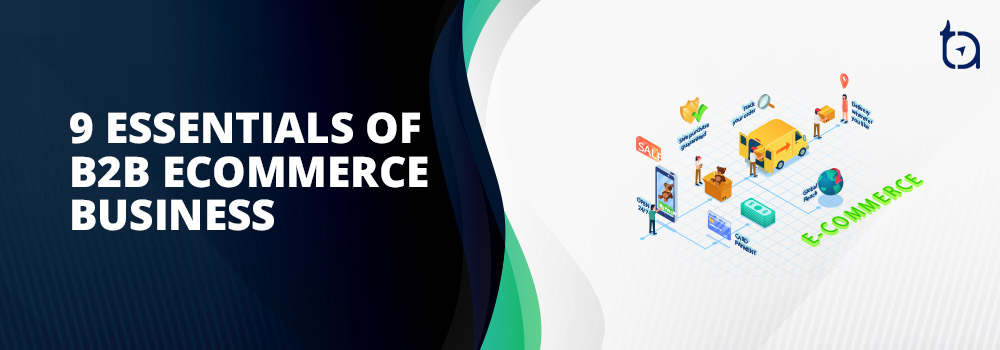9 Most Essential Things for an Engaging B2B eCommerce Website

Author : Abishek Surya RS 15th Sep 2020

In today’s world of ultra-competitive business, your B2B eCommerce website needs to stand out to capture the audience’s attention. According to eMarketer, US consumers will spend $709.78 billion on eCommerce in 2020. As per Kommando Tech, when it comes to B2B, more than 1.3 million companies use eCommerce in the United States. With this billion dollar market filled with devices of different aspect ratios and display resolutions, you must ensure responsive front-end design for your eCommerce store. Furthermore, your users have more merchants to choose from with each passing day as the competition only grows. Hence, it has accelerated the need to make websites feel attractive, engaging, and relevant. In this scenario, what are some of the significant aspects that make for an engaging B2B eCommerce website?
Be it compressing your image sizes, or ensuring the best shipping facilities, or making advanced analytics available to your B2B sellers, it is best to have the following aspects covered so that your B2B eCommerce website sets you up for success.
1. Mobile-ready
“Mobile accounts for approximately 50% of web traffic worldwide. In the second quarter of 2020, mobile devices (excluding tablets) generated 51.53% of global website traffic.”
– Statista
With this in mind, Google is also shifting to a mobile-first approach. There are a few benefits that your B2B eCommerce website would get if it is mobile-ready. First, it would show up much better in Google search results. Second, you can improve the overall experience of your website for your users.
2. SSL Protection
Secure Sockets Layer (SSL) is a standard security technology in establishing an encrypted link between a mail server and client. An SSL certificate is to verify that your website for eCommerce is secure against the leak and interception of user information.
The “https” in the URL of your website confirms this for the user. A smart user will check for this SSL and most of the users are smart. If users find it missing, then you might well be missing out on a lot of significant business opportunities.
It does not stop there!
Google wants to make sure that all websites take SSL encryption seriously. Your SEO score depends on whether your site is SSL protected for your users. You can improve your SEO score by making your site SSL encrypted.
You can get this done by submitting two sitemaps of your website to Google Webmaster Tools. As a result, you make sure your website is secure and ready to be indexed. One of the submitted sitemaps must be the “https” version, and the other sitemap must be the “http” version of your eCommerce website.
3. Actionable Web Content
Beginning with the homepage right down to your blog, your website content has to keep your audience engaged. You need to address each users’ specific needs and pain points as part of your business solution.
First, pay attention to the tone of your voice.
Decide on the brand voice and stick to it. It is crucial in building your brand because it reflects your brands’ personality. Remember that brand loyalty is key to your success. Engaging content will keep the audience on your site for much longer.
Second, your website has to have quality content. A few points to remember would be to focus on and highlight your central theme to your users. Ensure no grammatical errors using tools like Grammarly. Have a free and smooth flow of content. Also, changing the headlines, product descriptions, and CTAs periodically helps with your overall conversion rates.
Finally, use your brand personality to connect with your audience. It builds trust among your users. There are three stages to Inbound Marketing: Attract, Engage, Delight. Keeping up the promises and supporting the customer in their purchase cycle results in customer retention.
Delight is the phase where customer retention happens and customer retention is key to your success.
4. Using Optimized Product Images
Reducing image sizes is one of the primary ways of ensuring a fast loading website. A fast loading website ensures your customers navigate through your website seamlessly and fill their cart. It results in a decrease in the abandoning of carts and also results in lower bounce rates for your site.
The key is to do this without compromising on the quality of the actual image. You can do this by using Photoshop, choosing the “Save for Web” option, and selecting .jpg at 80% image quality. You might also use plugins like WP Smush to do the same. If all this feels too complicated, a web designer can do this work for you in no time.
5. Advanced B2B Analytics
In B2B eCommerce, personalized solutions are an important aspect of your business. The micro indicators here matter as much as the macro indicators. The reason being every customer here is very different and unique.You can establish and maintain a different set of Key Performance Indicators (KPIs) for each one of them.
For example, customers with the same product needs might have unique inventory and shipping needs. Thus, personalized solutions are the need of the hour.It also becomes equally important to have an analytics solution that tracks the KPI of every customer on an ongoing basis.
By doing so, you can study and track the catalogs, inventory, and contracts individually for each customer. Every lead is a potential high ticket repeat-customer, and makes sure to get a thorough knowledge of the lead’s business and requirements before closing the deal and onboarding the lead as a customer.
6. State-of-the-art Shipping Capabilities
One reason for heavy losses in B2B eCommerce is defective shipping. The problem starts even before shipping begins. Several factors lead to this scenario.
The top reasons for B2B consumers quitting on a merchant or abandoning cart include a complicated checkout process, expensive shipping costs, too many broken or damaged items, no provision for fast-tracking of cargo, and unexpected delivery charges.
Your business is safe only if your customers get a simple, transparent, fair, and reliable shipping service. Making the shipping process intuitive and automated is a strategy most businesses adopt these days.
Here are a few points to consider when trying to improve your shipping process.
- When operating from multiple locations, use automated order fulfillment.
- To cut costs and maintain standards, implement advanced carrier selection.
- Build a fast, scalable, and reliable shipping platform to improve efficiency.
7. Bulk Orders & Discounts
The volume of orders is an integral part of any B2B eCommerce website. With this in mind, two metrics need to be studied and monitored.
- Minimum Order Quantity
In B2B business, you will have a large number of products to sell on an everyday basis. You can calculate the minimum order quantity based on your loyal customers and ROI. This value helps to keep away the bargain shoppers, and your inventory moves fast.
- Bulk Order Discounts
It serves two purposes by helping you stay competitive and making customers come back for more. This way, you can restock your products and get rid of your perishables faster. You can get to offer bulk discounts on large quantities ordered.
Once the customer sees the savings on the higher amount of products, they might want to buy it and help you sell more and clear your inventory. For example, your bulk discount paves the way to sell a product at a batch of 30 instead of just 15.
8. Personalized Content
You need to make sure your customers get rich back-end customization as well as front-end experience. Every visitor needs to have his/her catalog and ordering option based on their preference and choice.
Here are some key B2B eCommerce solutions that might help you in this regard.
- Make a clear buyer persona to have a clear vision of what your customers might want.
- A consistent brand voice along each step of the buyer journey and across platforms.
- Start by measuring small metrics and eventually scale-up as you grow.
9. Customization
Every business is unique, and you need to customize your B2B eCommerce website accordingly. There are three ways to classify eCommerce platforms: open-source, SaaS, and Headless eCommerce. When your business needs 100% control of the eCommerce environment, an open-source eCommerce platform is preferred. An open-source platform gives you a lot more options and much better control over your website. You can include a lot of extensions, get community help, take advantage of certified professionals, and opt for specialized B2B analytics, to name a few benefits.
As your business grows, you will need your website to scale up as well to meet the demands of your customers. By running an open-source B2B website for eCommerce, you can tackle this challenge as well.
Final Thoughts
In summary, these are the nine recommendations that you must remember while setting up your B2B eCommerce website. You can take your business to the next level by implementing these steps. We are excited for you and hope to join you on your journey.
Would you like to work together in eCommerce development? We, at TechAffinity, have more than 20 years of experience in developing website development, mobile development, and eCommerce development. Feel free to share your project ideas with our experts by sending an email to media@techaffinity.com or schedule a meeting with us.
